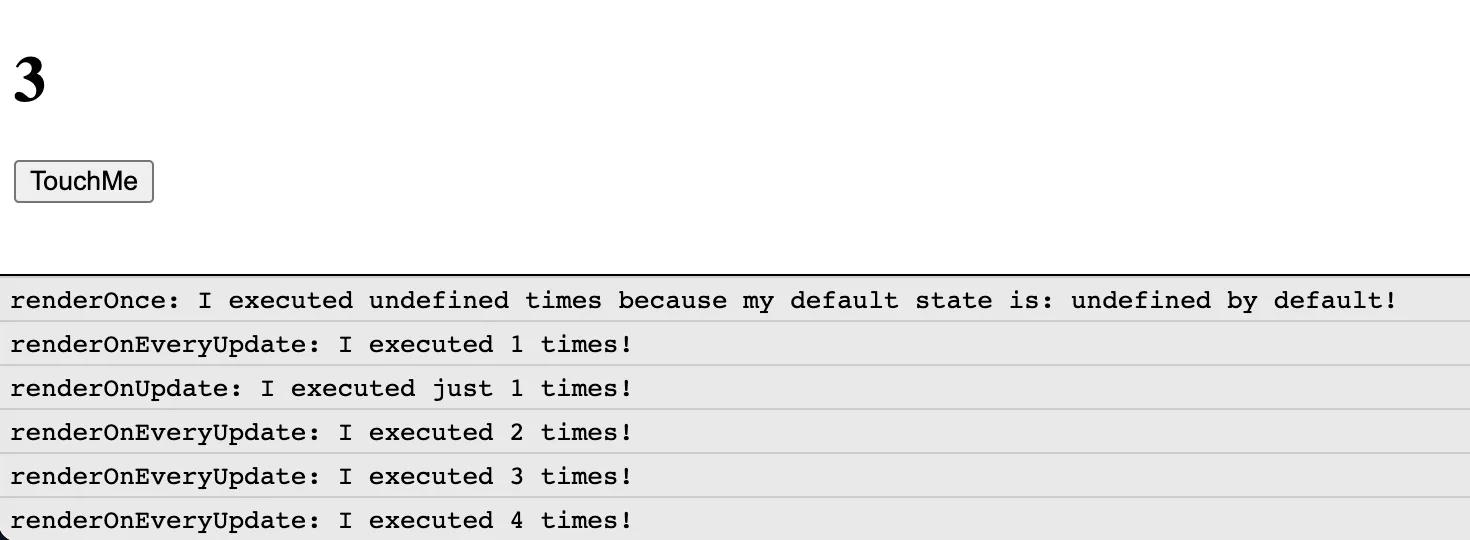在React函数组件中,是否有使用hooks模拟componentDidMount的方法?
React函数/钩子组件中的componentDidMount等效方法是什么?
针对Hooks的稳定版本(React 版本 16.8.0+)
针对 componentDidMount
useEffect(() => {
// Your code here
}, []);
对于componentDidUpdate方法
useEffect(() => {
// Your code here
}, [yourDependency]);
componentWillUnmount用于在React组件卸载之前执行一些清理操作。
useEffect(() => {
// componentWillUnmount
return () => {
// Your code here
}
}, [yourDependency]);
const [count, setCount] = useState(0);每当计数增加时,您希望重新渲染函数组件。然后,您的useEffect应该如下所示。useEffect(() => {
// <div>{count}</div>
}, [count]);
这样,每当您的计数更新时,您的组件将重新渲染。希望这能有所帮助。
8
在React Hooks中,没有与componentDidMount完全相等的对应方法。
根据我的经验,使用React Hooks需要一种不同的开发思维方式,一般来说,你不应该将其与类方法(如componentDidMount)进行比较。
话虽如此,你可以通过某些方式使用Hooks产生类似于componentDidMount的效果。
解决方案1:
useEffect(() => {
console.log("I have been mounted")
}, [])
解决方案2:
const num = 5
useEffect(() => {
console.log("I will only run if my deps change: ", num)
}, [num])
解决方案 3(使用函数):
useEffect(() => {
const someFunc = () => {
console.log("Function being run after/on mount")
}
someFunc()
}, [])
解决方案4(useCallback):
const msg = "some message"
const myFunc = useCallback(() => {
console.log(msg)
}, [msg])
useEffect(() => {
myFunc()
}, [myFunc])
解决方案5(创意方法):
export default function useDidMountHook(callback) {
const didMount = useRef(null)
useEffect(() => {
if (callback && !didMount.current) {
didMount.current = true
callback()
}
})
}
值得注意的是,只有在其他解决方案都无法满足您的用例时,才应真正使用解决方案5。如果您决定需要解决方案5,则建议使用此预制挂钩use-did-mount。
来源(更多细节):在React Hooks中使用componentDidMount。
在函数式组件中没有componentDidMount,但是React Hooks提供了一种方法,可以通过使用useEffect hook来模拟其行为。
将空数组作为第二个参数传递给useEffect(),以仅在挂载时运行回调函数。
请阅读有关useEffect的文档。
function ComponentDidMount() {
const [count, setCount] = React.useState(0);
React.useEffect(() => {
console.log('componentDidMount');
}, []);
return (
<div>
<p>componentDidMount: {count} times</p>
<button
onClick={() => {
setCount(count + 1);
}}
>
Click Me
</button>
</div>
);
}
ReactDOM.render(
<div>
<ComponentDidMount />
</div>,
document.querySelector("#app")
);<script src="https://unpkg.com/react@16.7.0-alpha.0/umd/react.development.js"></script>
<script src="https://unpkg.com/react-dom@16.7.0-alpha.0/umd/react-dom.development.js"></script>
<div id="app"></div>useEffect() 钩子使我们能够实现componentDidMount,componentDidUpdate和componentWillUnMount功能。
useEffect()的不同语法可以实现上述每种方法。
i) componentDidMount
useEffect(() => {
//code here
}, []);
ii) componentDidUpdate
useEffect(() => {
//code here
}, [x,y,z]);
//where x,y,z are state variables on whose update, this method should get triggered
iii) componentDidUnmount
useEffect(() => {
//code here
return function() {
//code to be run during unmount phase
}
}, []);
你可以查看官方的React网站获取更多信息。 有关Hooks的React官方页面
它有时会导致问题,可能会给您带来不可预测的输出。因此,我建议您花一点力气将函数重写为类。更改很少,您可以将某些组件设置为类,将某些组件设置为函数。您不必只使用一种约定。
以这个为例。
function App() {
const [appointments, setAppointments] = useState([]);
const [aptId, setAptId] = useState(1);
useEffect(() => {
fetch('./data.json')
.then(response => response.json())
.then(result => {
const apts = result.map(item => {
item.aptId = aptId;
console.log(aptId);
setAptId(aptId + 1);
return item;
})
setAppointments(apts);
});
}, []);
return(...);
}
和
class App extends Component {
constructor() {
super();
this.state = {
appointments: [],
aptId: 1,
}
}
componentDidMount() {
fetch('./data.json')
.then(response => response.json())
.then(result => {
const apts = result.map(item => {
item.aptId = this.state.aptId;
this.setState({aptId: this.state.aptId + 1});
console.log(this.state.aptId);
return item;
});
this.setState({appointments: apts});
});
}
render(...);
}
这仅供示例。因此,我们不要讨论最佳实践或代码的潜在问题。这两个都具有相同的逻辑,但后者只能按预期工作。您可能会在此次运行中使用useEffect获取componentDidMount功能,但随着应用程序的增长,您可能会面临一些问题。因此,与其在那个阶段重写代码,不如在早期进行操作。
此外,OOP并不那么糟糕,如果过程式编程足够好,我们就永远不会有面向对象编程。有时候会很痛苦,但从技术上来说更好(个人问题除外)。
2
setState的回调版本或将有问题的函数完全移出渲染周期通常可以解决问题 - 如果不行,那么你的状态可能太复杂了,需要实现自己的reducer。Hooks并非强制要求,但显然是React的未来。我建议阅读这篇优秀的关于useEffect的文章 - 当我开始遇到这些问题时,它确实帮助我理解了它。 - lawrence-witt是的,有一种方法可以在React函数组件中模拟componentDidMount
免责声明:真正的问题是,您需要从“组件生命周期思维方式”转变为“useEffect思维方式”
一个React组件本质上还是一个JavaScript函数,所以如果您想要在某个其他东西之前执行某些操作,只需从上到下先执行它即可。 如果你仔细想想,函数仍然是一个函数,例如:
const myFunction = () => console.log('a')
const mySecondFunction = () => console.log('b)
mySecondFunction()
myFunction()
/* Result:
'b'
'a'
*/
这真的很简单,不是吗?
const MyComponent = () => {
const someCleverFunction = () => {...}
someCleverFunction() /* there I can execute it BEFORE
the first render (componentWillMount)*/
useEffect(()=> {
someCleverFunction() /* there I can execute it AFTER the first render */
},[]) /*I lie to react saying "hey, there are not external data (dependencies) that needs to be mapped here, trust me, I will leave this in blank.*/
return (
<div>
<h1>Hi!</h1>
</div>
)}
在这种特定情况下是正确的。但是如果我做类似于这样的事情会发生什么:
const MyComponent = () => {
const someCleverFunction = () => {...}
someCleverFunction() /* there I can execute it BEFORE
the first render (componentWillMount)*/
useEffect(()=> {
someCleverFunction() /* there I can execute it AFTER the first render */
},[]) /*I lie to react saying "hey, there are not external data (dependencies) that needs to be maped here, trust me, I will leave this in blank.*/
return (
<div>
<h1>Hi!</h1>
</div>
)}
我们定义的这个“cleverFunction”在组件每次重新渲染时并不是相同的。 这会导致一些恶心的错误,有时还会导致组件不必要的重新渲染或无限的重新渲染循环。
真正的问题在于React函数组件是一个函数,通过useEffect钩子(等等)多次“执行自身”取决于你的状态。
简而言之,useEffect是一个专门设计用于将数据与屏幕上看到的内容同步的钩子。如果您的数据发生更改,则需要使useEffect钩子意识到这一点,始终如此。这包括您的方法,因为那就是数组依赖项。 未定义它会让您暴露于难以发现的错误中。
因此,了解这背后的工作原理以及您可以如何以“react”的方式获得所需非常重要。
const initialState = {
count: 0,
step: 1,
done: false
};
function reducer(state, action) {
const { count, step } = state;
if (action.type === 'doSomething') {
if(state.done === true) return state;
return { ...state, count: state.count + state.step, state.done:true };
} else if (action.type === 'step') {
return { ...state, step: action.step };
} else {
throw new Error();
}
}
const MyComponent = () => {
const [state, dispatch] = useReducer(reducer, initialState);
const { count, step } = state;
useEffect(() => {
dispatch({ type: 'doSomething' });
}, [dispatch]);
return (
<div>
<h1>Hi!</h1>
</div>
)}
useReducer的dispatch方法是静态的,这意味着无论您的组件重新渲染多少次,它都将是相同的方法。因此,如果您想执行一些操作仅一次,并且希望在组件挂载后立即执行,可以像上面的示例那样做。这是一种声明性的正确方式。
来源:完整指南useEffect-作者Dan Abramov
话虽如此,如果您喜欢尝试各种事物并想知道如何“命令式地”执行它,可以使用useRef()与计数器或布尔值一起使用,以检查该引用是否存储了定义的引用。这是一种命令式的方法,如果您不熟悉react在幕后发生的情况,建议避免使用它。
这是因为useRef()是一个钩子,无论渲染的次数如何,它都会保存传递给它的参数(我之所以简单解释是因为这不是问题的重点,你可以阅读这篇精彩文章了解useRef)。因此,这是最好的方法来知道组件的第一次渲染发生的时间。
我留下一个示例,展示了同步“外部”效果(如外部函数)与“内部”组件状态的3种不同方式。
您可以在此处运行此片段以查看日志并了解这3个函数何时执行。
const { useRef, useState, useEffect, useCallback } = React
// External functions outside react component (like a data fetch)
function renderOnce(count) {
console.log(`renderOnce: I executed ${count} times because my default state is: undefined by default!`);
}
function renderOnFirstReRender(count) {
console.log(`renderOnUpdate: I executed just ${count} times!`);
}
function renderOnEveryUpdate(count) {
console.log(`renderOnEveryUpdate: I executed ${count ? count + 1 : 1} times!`);
}
const MyComponent = () => {
const [count, setCount] = useState(undefined);
const mounted = useRef(0);
// useCallback is used just to avoid warnings in console.log
const renderOnEveryUpdateCallBack = useCallback(count => {
renderOnEveryUpdate(count);
}, []);
if (mounted.current === 0) {
renderOnce(count);
}
if (mounted.current === 1) renderOnFirstReRender(count);
useEffect(() => {
mounted.current = mounted.current + 1;
renderOnEveryUpdateCallBack(count);
}, [count, renderOnEveryUpdateCallBack]);
return (
<div>
<h1>{count}</h1>
<button onClick={() => setCount(prevState => (prevState ? prevState + 1 : 1))}>TouchMe</button>
</div>
);
};
class App extends React.Component {
render() {
return (
<div>
<h1>hI!</h1>
</div>
);
}
}
ReactDOM.createRoot(
document.getElementById("root")
).render(
<MyComponent/>
);<div id="root"></div>
<script src="https://cdnjs.cloudflare.com/ajax/libs/react/18.1.0/umd/react.development.js"></script>
<script src="https://cdnjs.cloudflare.com/ajax/libs/react-dom/18.1.0/umd/react-dom.development.js"></script>
import React, { useState, useEffect } from 'react';
function Example() {
const [count, setCount] = useState(0);
// Similar to componentDidMount and componentDidUpdate:
useEffect(() => {
// Update the document title using the browser API
document.title = `You clicked ${count} times`;
});
return (
<div>
<p>You clicked {count} times</p>
<button onClick={() => setCount(count + 1)}>
Click me
</button>
</div>
);
}
请访问此官方文档。非常易懂,采用了最新的方式。
关于钩子内异步函数的信息:
为了防止竞态条件,Effect 回调是同步的。请将异步函数放在内部:
useEffect(() => {
async function fetchData() {
// You can await here
const response = await MyAPI.getData(someId);
// ...
}
fetchData();
}, [someId]); // Or [] if effect doesn't need props or state
useLayoutEffect钩子是React Hooks中替代ComponentDidMount的最佳选择。
useLayoutEffect钩子在渲染UI之前执行,而useEffect钩子在渲染UI之后执行。根据您的需求使用它。
示例代码:
import { useLayoutEffect, useEffect } from "react";
export default function App() {
useEffect(() => {
console.log("useEffect Statements");
}, []);
useLayoutEffect(() => {
console.log("useLayoutEffect Statements");
}, []);
return (
<div>
<h1>Hello Guys</h1>
</div>
);
}
你想要使用 useEffect(),它根据函数的使用方式,可以像 componentDidMount() 一样工作。
例如,你可以使用自定义的 loaded 状态属性,将其最初设置为 false,并在渲染时将其切换为 true,并仅在该值更改时触发效果。
1
原文链接
- 相关问题
- 3 在React组件中传递props到componentDidMount()方法
- 7 在Flutter中,`componentDidMount()`的等效方法是什么?
- 10 React函数组件:如何使用componentDidMount()
- 12 React组件层次中componentDidMount的顺序
- 43 React钩子和组件生命周期等效性
- 3 React暴露组件函数并使用ComponentDidMount获取数据
- 3 React类组件中this.props.history.push('/some_route')的Hooks等效方法是什么?
- 14 React类组件中的useLayoutEffect等效方法
- 10 React - useEffect钩子函数 - 从componentDidMount到useEffect
- 8 React类组件中的useEffect等效方法
useState中还有第二个参数。对于任何阅读此内容的人,请记住,如果将第二个参数保留为undefined,则会在每次渲染时触发您的 effect(如果我没有弄错的话)。 - dimiguel